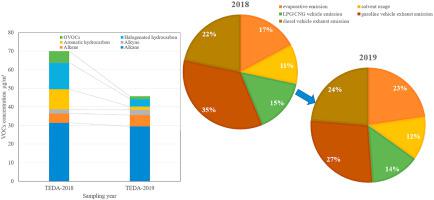Atmospheric Environment ( IF 4.2 ) Pub Date : 2021-08-14 , DOI: 10.1016/j.atmosenv.2021.118670 Qijun Zhang 1 , Luna Sun 1 , Ning Wei 1 , Lin Wu 1 , Hongjun Mao 1

|
To research the effect of ethanol-gasoline on the VOCs emission from vehicles, two long-term roadside experiments were carried out to obtain the characteristics of VOCs emissions from vehicles at TEDA road in Tianjin. The Positive Matrix Factorization (PMF) source analysis model is used to analyze the VOCs at roadside and assess the impact of ethanol-gasoline implementation. The results show that the average VOCs concentration in the roadside environment was 45.67 ± 34.60 μg/m3 in the 2019 experiment. Alkanes, alkenes, halogenated hydrocarbons, alkynes, aromatic hydrocarbons and oxygen volatile organic compounds (OVOCs) accounted for 63.18%, 13.24%, 9.04%, 6.03%, 5.35% and 3.16%, respectively. Compared with the experiment in 2018, the concentration of m/p-xylene and benzene in the roadside environment showed a significant decrease. Five VOCs sources were identified, including gasoline vehicle exhaust emissions (27.46%), diesel vehicle exhaust emissions (23.70%), evaporative emission (22.67%), LPG/CNG vehicle emission (13.86%) and solvent usage (12.30%). The PMF analysis results of 2018 and 2019 showed that the contribution of gasoline vehicle exhaust emissions decreased by 8%, but the contribution rate of evaporative emissions increased by 6%. The implementation of ethanol-gasoline can reduce VOCs emissions from vehicle exhaust, however, the evaporative emissions of VOCs will increase. Evaporative emission from vehicles should be strictly controlled in the future.
中文翻译:

路边VOCs排放特征及来源分析:评估乙醇汽油实施的影响
为研究乙醇汽油对车辆VOCs排放的影响,通过两次长期路边试验,获得天津泰达路车辆VOCs排放特征。正矩阵分解 (PMF) 源分析模型用于分析路边的 VOC,并评估乙醇汽油实施的影响。结果表明,路边环境中VOCs平均浓度为45.67±34.60 μg/m 3在 2019 年的实验中。烷烃、烯烃、卤代烃、炔烃、芳烃和氧挥发性有机化合物(OVOCs)分别占63.18%、13.24%、9.04%、6.03%、5.35%和3.16%。与2018年的实验相比,路边环境中间对二甲苯和苯的浓度出现明显下降。确定了五个VOCs来源,包括汽油车尾气排放(27.46%)、柴油车尾气排放(23.70%)、蒸发排放(22.67%)、LPG/CNG车尾排放(13.86%)和溶剂使用量(12.30%)。2018、2019年PMF分析结果显示,汽油车尾气排放贡献率下降8%,但蒸发排放贡献率上升6%。乙醇汽油的实施可以减少汽车尾气中VOCs的排放,但VOCs的蒸发排放量会增加。今后应严格控制车辆蒸发排放。











































 京公网安备 11010802027423号
京公网安备 11010802027423号